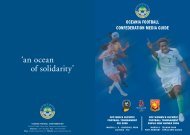2006 OFC U-20 Women's Championship Toleafoa JS Blatter Football
2006 OFC U-20 Women's Championship Toleafoa JS Blatter Football
2006 OFC U-20 Women's Championship Toleafoa JS Blatter Football
You also want an ePaper? Increase the reach of your titles
YUMPU automatically turns print PDFs into web optimized ePapers that Google loves.
Table 1. Injury statistics according to type, location, playing position and time of game.<br />
Total After Groups stage<br />
Ankle 18 11<br />
Knee 8 6<br />
Quad 4 4<br />
Head, face or neck 3 3<br />
Toe 2 2<br />
Shin 2 2<br />
Shoulder 2 1<br />
Torso 3 1<br />
Elbow 1 1<br />
1 st quarter 8 7<br />
2 nd quarter 15 9<br />
3 rd quarter 5 5<br />
4 th quarter 15 10<br />
Contusion 23 17<br />
Strain 9 6<br />
Sprain 10 6<br />
Laceration 1 2<br />
Goalkeeper 6 3<br />
Defender 13 9<br />
Midfield 11 7<br />
Forward 10 9<br />
Unknown 3 3<br />
There were more injuries to outfield players than to goalkeepers but as goalkeepers made up 11% of the total number of players<br />
present, their actual rate of injury was the highest. At this level of competition, further analysis of injury incidence by playing<br />
position isn’t reliable as players often changed position, both within and between games, but results are reported for<br />
completeness.<br />
Most injuries (79%) were to the lower extremities which is similar to the incidence seen in other football tournaments and female<br />
national leagues (Faude et al. <strong>20</strong>05). Recurrent ankle sprains and strains are of particular concern and may reflect inherent<br />
weakness, failure to manage a previous injury effectively or poor quality training facilities. These pre-disposing factors should be<br />
investigated further to reduce injury occurrence in future games/tournaments.<br />
The most common type of injury was a bruise or contusion caused by contact with another player or the ground. No concussions,<br />
fractures or dislocations were reported. Injury surveillance is an important tool to highlight issues and guide intervention strategies.<br />
2. Injury management<br />
The management of injured players is important and appropriate action should<br />
always be taken to ensure that player welfare is monitored.<br />
Only 4 of the 8 teams had some form of medical personnel within their support staff.<br />
Whilst icing of injuries was observed, this was generally not for long enough and/or<br />
was not repeated over the recommended time frame (15 minutes, every 2 hours, for<br />
48 hours).<br />
Strapping was widely used, for treatment rather than prevention. Three players were<br />
taken to hospital for further examination with one being diagnosed with a minor<br />
ankle injury. The other two were diagnosed with significant knee ligament damage,<br />
requiring rest for at least 7 days.<br />
Failure to rest injured players was common throughout the tournament with an opportunity for minor injuries to become more<br />
serious, increasing the ultimate recovery time and limiting performance and or players not being available layer in the tournament.<br />
Immediate injury management was provided by a combination of team personnel (some qualified, some not) and the Red Cross.<br />
Event Report and Statistics– <strong><strong>20</strong>06</strong> <strong>OFC</strong> U-<strong>20</strong> Women’s <strong>Championship</strong> – Samoa<br />
9





